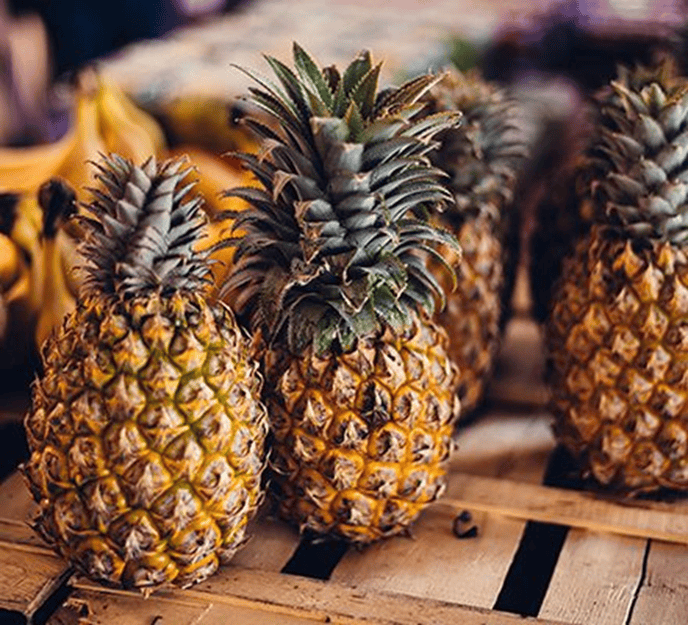The Pineapple: A Symbol of Southern Welcome

We have all heard how the South is renowned for its hospitable nature, but did you know that a non-Southern fruit – the pineapple – symbolizes that hospitality? Below, learn how this delectable fruit became a symbol of welcome.
Indigenous to South America around present-day Brazil, Paraguay, and Argentina, the pineapple was an important staple crop to the Tupi-Guarani and Carib peoples, who called it nanas (excellent fruit). In addition to being food, they employed pineapple as medicine, fermented it to become alcohol, and made its fibers into robes, bow strings, and thread for cloth.
The first documented European encounter with the pineapple came in 1493, when Christopher Columbus supposedly discovered pineapples on the island of Guadeloupe and successfully brought one back to Spain. Other early European explorers and colonizers, too, were enamored with this fruit, often praising it in the chronicles of their voyages as “the prince of all fruits.”
By the 1550s, Europeans regularly shipped pineapples from the Caribbean to their homeland. The fruit was costly cargo and often rotted in the bowels of ships during the long journey. This made it a rare luxury; one pineapple could cost as much at $8000 in today’s dollars. Later, Europeans grew pineapples in cooler climates thanks to the development – at huge costs – of glass houses. The costliness of both shipping and cultivating the pineapple meant few could afford to procure it.
In Europe, pineapples became a symbol of exoticism, power, and wealth. as the main attraction on seventeenth-century menus. Some hosts chose to simply slice and plate the pineapple in its natural state, while others had the fruit candied or turned into sorbets and ice creams. They intended guests feel intimidated by these ostentatious displays and honored that the host spared no expense for their enjoyment. For those who could not afford to purchase the fruit, shops and merchants would rent pineapples for the day as a cost- and face-saving measure.
American colonists began importing the pineapple from the Caribbean in the 17th century. Because trade routes between America and the Caribbean were often slow and perilous, guests considered it a significant achievement for a host to procure a ripe pineapple for them. Southern planters saw the pineapple as a cash crop and began growing small clusters in custom-built hot houses, but the imported pineapple remained a coveted luxury item.
The cult of the pineapple also extended to architecture and art. By the beginning of the eighteenth century, the image of the pineapple appeared painted on fine China, carved into columns, or sculpted and placed on pillars at the entrances to palaces, churches and grand homes throughout England and France. For instance, carved representations sit atop the towers of St. Paul’s Cathedral in London. In eighteenth- and nineteenth-century America, the pineapple frequently decorated bed posts, tablecloths, napkins, and anything associated with welcoming guests.
There are a few theories as to why the pineapple became a symbol of hospitality. Historians believe wealthy European travelers who found pineapples hung outside entrances to Caribbean villages were greeted warmly by the native people. Similarly, some accounts tell of sea captains who, upon returning from trade routes in the Caribbean or Pacific, would place a pineapple outside their homes as a symbol of their safe return and an invitation to stop by to hear tales of the captain’s time at sea. Due to its association with warmth and friendliness, pineapples in America were often used as the “crowning” piece in large displays of food.
Therefore, the next time you serve pineapple to family or friends, make it not only a symbol of hospitality but a conversation piece, as you may now recount its storied past to those you welcome to your table.
Learn more about pineapples and Southern traditions on our Cumberland Island Walking Tour: Haunting Ruins and Wild Horses or our St. Marys Fugitives, Fighters, and Fudge Tour!



